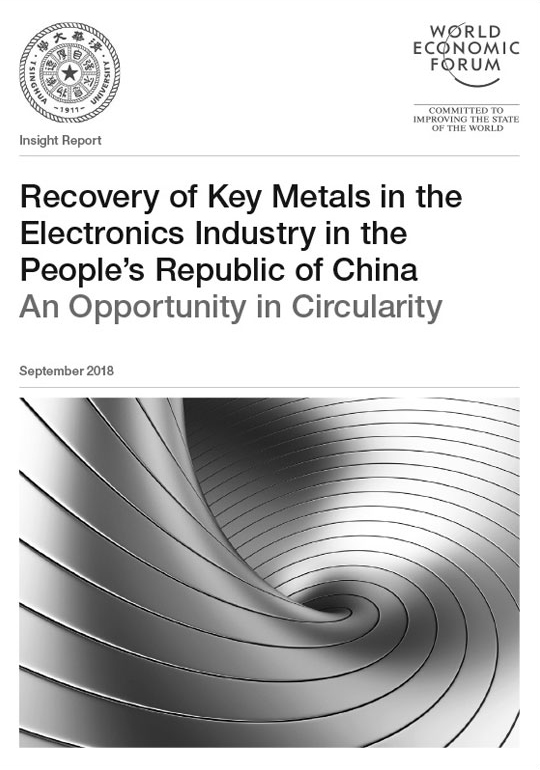The Circular Economy Action Agenda for Electronics





Global Battery Alliance seeks to ensure that the battery value chain is socially responsible, environmentally and economically sustainable and innovative.
By 2025, the battery market will reach $100 billion, primarily driven by the growing global stock of electric vehicles. However, this growth comes at a social and environmental toll
Raw materials needed for batteries are linked to social and environmental issues
No scaled systems are in place to enable re-use and recycling of over 11 million tons of the spent lithium-ion batteries forecast to be discarded by 2030
Innovation potential remains unexploited along the value chain, holding back greater supply chain transparency, business model and technological innovation
Support responsible and sustainable supply chains of key raw materials
Accelerate the transition towards a circular economy for batteries
Support collaboration to unlock innovation along the value chain
With respect to circular economy pillar in the Alliance:
The circular economy market and its potential evolution over time will be assessed in a scoping study (by early 2019)
Opportunities to lower repurposing and re-use costs for batteries will be assessed (e.g. standard-setting, establishing a framework to help address regulatory and liability challenges)
Barriers to recycling of electric vehicle battery will be quantified and a public-private pilot launched to test scalable solutions
A portable electronics collection pilot is being scoped to test how materials can be recovered more efficiently
Responsible Business Alliance (RBA), World Economic Forum, African Development Bank, Responsible Business Alliance, UNEP, Amara Raja Group, Audi, BASF, BMW, BP, China Chamber of Commerce of Metals, Minerals and Chemicals Importers and Exporters, Clarios, ClimateWorks Foundation, Deme Group, GIZ, Enel, Envision Group, ERG, Everledger, Fairphone, Glencore, Good Shepherd International Foundation, Google, Groupe Renault, Honda, Huayou Cobalt, International Energy Agency, Johnson Matthey, LeasePlan, LG Chem, London Metal Exchange, Mahindra, NPL, OECD, Pact, Pure Earth, RCS Global, RESOLVE, Responsible Battery Coalition, Saft, SAP, SK Innovation, Signify, Stanley Black & Decker, Center for Business and Human Rights at the Stern School of Business (New York University), Sociedad Quimica y Minera de Chile (SQM), Trafigura Group, Transport & Environment, Umicore, UNICEF, Vale, Volkswagen Group, Volvo Group, Wesfarmers, World Bank Group.
2. Enable Producers to Increase Sourcing of Recycled Content
4. Guide and Support New Business Models for Environmental, Financial, and Social Triple-Win
6. Set Up Effective Collection Systems
The project aims to support effective systems for the integration of recycled materials into electronic products and equipment along with other circular economy strategies. Through collaboration between multinational businesses, government and the domestic material recovery sector, work will seek to co-design pilot projects which test new regulatory approaches, technologies and partnerships.
Help the Chinese government reach its target or recycling 50% of e-waste by 2025 and sourcing 20% of materials for products from recycled sources.
Major electronic companies have set targets to use secondary materials in new products and other strategies to accelerate the circular economy
China is leading electronics manufacturing & has high targets for circular economy in electronics
Only $160m of value is recovered of a potential $1.3 billion worth of materials
Limited understanding of secondary material market scale, potential and operations in China
Informal secondary material processing in China is dominant
Create a platform for public-private collaboration between electronics companies and the Chinese government
Move towards piloting new strategies for circular economy in electronics
Undergo research to increase the base of knowledge on circular electronics in China
World Economic Forum, China Association of Circular Economy, China National Resources Recycling Association, Apple, Huawei, GEM, DELL Technologies, Philips Health. Xiaomi, Oppo, Aihuishou, Huishoubao, TES-AMM, JD, HPE, Huirong, TES-AMM (data center servers), GE Healthcare, Siemens Healthineers, United Imaging (medical imaging equipment)
6. Set Up Effective Collection Systems
10. Integrate and Advance Decent Work in the Transition to a Circular Economy for Electronics
Create one model for a circular electronics system to be applied in Nigeria and replicated across other countries in Africa.
In 2018, 50 million metric tonnes of e-waste was generated and
E-waste is one of the fastest-growing waste streams globally
Only 20% of e-waste is recycled through appropriate channels
E-waste contains high-value materials, with an estimated value of $55 billion
Informal e-waste processing poses significant health and environmental hazards
To stimulate the development of a sustainable and circular management system of electronics products in Nigeria
Develop a model for scaling to other African countries
This project aims to advance a systemic change in the way the value of electronics is captured in Africa. By convening public and private partners, it supports: (1) the recovery of valuable materials contained in electronics at the end of their use for their reuse in local production processes: (2) the safe handling of the hazardous components included in electronics waste; and (3) strengthen the enabling conditions for a self-sustaining system of extended producers responsibility legislation for the electronics sector in Nigeria.
UNEP (leading partner), National Environmental Standards and Regulations Enforcement Agency of Nigeria (NESREA), E-Waste Producer Responsibility Organisation Nigeria (EPRON), Hinckley, UNU, GEF, with support from Philips, Dell, Hewlett Packard, Microsoft, World Economic Forum.